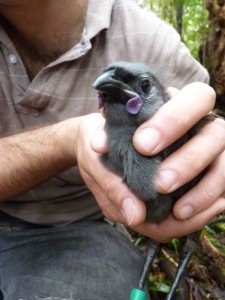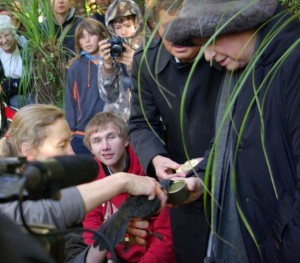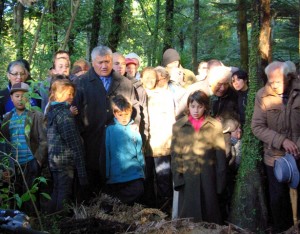I must say I was more than a little anxious about the fate of the Kokako released in 2009 into the Ark in the Park area of the Cascades. That photo (below) shows me feeding one at the release. The funny hat is because it was so damned cold in the kauri forest at 5 am in the morning. I worried about these birds because there were only a few and a big big forest to find each other to breed.
Yesterday (3 March) the Ark team told me that they are still in touch with 17 or 18 of the 22 Kokako that were progressively released over 2009 and 2010 after that initial release day.
And here’s the even more wonderful bit ” they think they have three fledglings from those birds and the photo is of Miro (a boy), one of the three. This is the first breeding of Kokako in the Waitakeres for 80 years.
Miro’s parents are Maurice and Kowhai , and they were released in 2009 having come from Waipapa. Their nest was found in November 2010 by Ark volunteers and when this happens the Ark people put a ring of steel around the nest, intensively trapping and baiting around the nest site to eliminate any predators.
Maurice and Kowhai’s nest is between the Waitakere dam and Anawhata Road and there are other Kokako known to be just eastwards of Anawhata Road near the Centennial Track entrance.
Another chick Brittany was born to Moby and Punga in a northern area just outside the Ark zone. The parents came from Tiritiri Matangi in 2010 and are very socialised to humans. The owners of the private land have fully cooperated with the Ark and allowed nest watches and intensive trapping on their land.
A third chick may have been born to Totara and Puke, also 2009 release birds from Waipapa, but the bush is so dense near Ian Wells Track where they’ve made their nest that it has not been found, but their behaviour conforms to what is known as nesting behaviour and later an unidentified third bird was seen with them.
Besides being very beautiful and having a haunting song, Kokako mate and nest for life and stay in a defined territory. They like tall canopy trees such as rimu and rata rather than lower kanuka forest.
Ark in the Park is a partnership between the Royal Forest and Bird Society and Auckland Council on the Waitakere Ranges Regional Parkland.
For more on Ark in the Park http://www.arkinthepark.org.nz/bulletins_and_news/news_text.html





